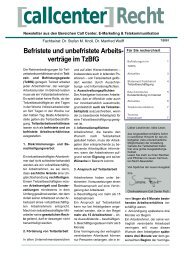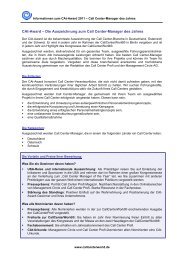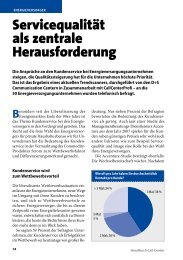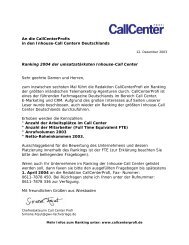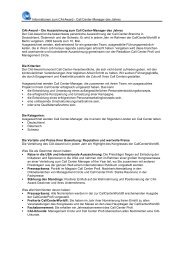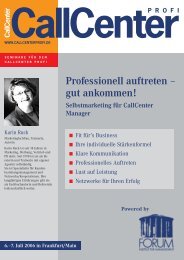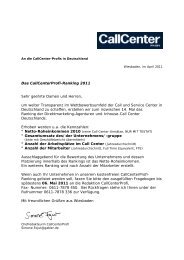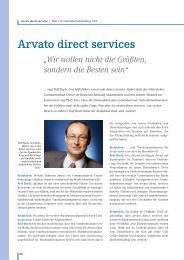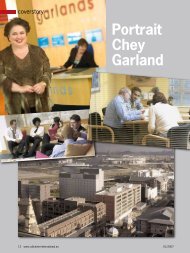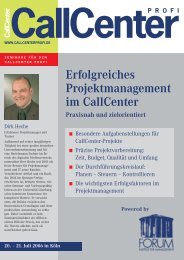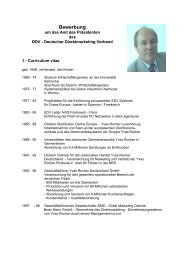Six Sigma in the call centre - CallCenter PROFI
Six Sigma in the call centre - CallCenter PROFI
Six Sigma in the call centre - CallCenter PROFI
- No tags were found...
You also want an ePaper? Increase the reach of your titles
YUMPU automatically turns print PDFs into web optimized ePapers that Google loves.
<strong>call</strong> <strong>centre</strong>ues which are better than <strong>the</strong> agreedvalues, a superproportionate numberof employees had to be appo<strong>in</strong>ted.Thus, it is recommended not to reduce<strong>the</strong> specification of a certa<strong>in</strong>service to an average value, but alsodef<strong>in</strong>e limits toge<strong>the</strong>r with <strong>the</strong> customerwhich are not allowed to beexceeded or fall below. This is exactlywhere <strong>Six</strong> <strong>Sigma</strong> starts and describes<strong>the</strong> USL (Upper Specification Limit)and <strong>the</strong> LSL (Lower SpecificationLimit) as limits to be fixed around anaverage value, precisely def<strong>in</strong><strong>in</strong>g <strong>the</strong>allowed statistic variations. The name<strong>Six</strong> <strong>Sigma</strong> orig<strong>in</strong>s from <strong>the</strong> fact that<strong>the</strong> (nearly) perfect product service or<strong>the</strong> (nearly) perfect product on <strong>the</strong>Upper and Lower Level SpecificationLimit (USL and LSL) is def<strong>in</strong>ed withan <strong>in</strong>terval of six standard deviations(= <strong>Six</strong> <strong>Sigma</strong>) from <strong>the</strong> average value.If values are measured beyond specificationlimits, it is <strong>call</strong>ed a “defect”.Statisticians know that, with a probability(standard probability) of tenmillion “ events”, defects that are beyond<strong>the</strong> <strong>Six</strong> <strong>Sigma</strong> limits (USL andLSL), will show a frequency of 34. Inour example, this means that “<strong>Six</strong><strong>Sigma</strong> Performance” will be reached<strong>the</strong> moment, ten million abandonedrates are measured without exceed<strong>in</strong>g<strong>the</strong> specification for more than 34times. In which way would this approachmake sense <strong>in</strong> practice? Doyou have to measure ten millionabandon rates <strong>in</strong> order to be able tomake a statistic statement?AuthorNael El Sayed,Manag<strong>in</strong>g Director,asdirekt, Germany.nael.elsayed@asdirekt.deCall Failure Rate12,00%10,00%8,00%6,00%4,00%2,00%0,00%1 2 3 4 5 6 7 8 9 10 11 12 13 14 15 16 17 18 19 20 21 22 23 24 25 26 27 28 29 30Abandon rates: Important<strong>in</strong>dicator for <strong>the</strong> qualityThe previous diagram po<strong>in</strong>ts up thisdiscussion and can be a start<strong>in</strong>g po<strong>in</strong>tfor <strong>the</strong> practical discussion:The diagram shows two possibleways of distribution for abandon ratefrequencies, with two different standarddeviations (<strong>Sigma</strong> = four per<strong>centre</strong>spectively <strong>Sigma</strong> = 12 percent) froma midpo<strong>in</strong>t (eight percent). The smaller<strong>the</strong> standard aviation is, <strong>the</strong> morefrequent are <strong>the</strong> measured avaragevalues which circle ‘‘around a midpo<strong>in</strong>t”.Before measur<strong>in</strong>g abondonrates accord<strong>in</strong>g to <strong>Six</strong> <strong>Sigma</strong> conformity,we will have to check threefacts with <strong>the</strong> customer:n How will an abandon rate bemeasured as an event? A time <strong>in</strong>tervalcan be chosen, e.g. like measur<strong>in</strong>g<strong>the</strong> abandon rate every half hour. Butit is far better to measure <strong>the</strong> abandonrates <strong>in</strong> <strong>in</strong>tervals, e.g. every 100oder 200 <strong>call</strong>s. The result (<strong>the</strong> averageabandon rate out of 100 or 200<strong>call</strong>s) is equal to <strong>the</strong> frequency of one.Throughout constant measurementsyou will receive a population of measuredresults which can be used forfur<strong>the</strong>r data collection.n Which average value does <strong>the</strong> customerexpect? For <strong>the</strong> sake of clarity,it is of major importance <strong>in</strong> whichtime <strong>in</strong>tervals <strong>the</strong> average values willbe measured. Most typi<strong>call</strong>y, averagevalues are measured <strong>in</strong> a monthlyrhythm.n Which k<strong>in</strong>d of standard deviationaccord<strong>in</strong>g to <strong>Sigma</strong> and which vari-pp_barL_confU_confp= <strong>call</strong> failure rate from <strong>the</strong> amount of spot checksp_bar, <strong>the</strong> current average value of <strong>the</strong> amount of spot checks,L_conf and U_conf, <strong>the</strong> lower or upper confidence <strong>in</strong>tervalIt is pla<strong>in</strong> to see that <strong>in</strong> a long-term period of time, <strong>the</strong> confidence <strong>in</strong>terval isshr<strong>in</strong>k<strong>in</strong>g and as such helps to get a clear statement about <strong>the</strong> real <strong>call</strong> failurerate.ance is acceptable for <strong>the</strong> customer?Which standard deviation can be calculatedwith<strong>in</strong> a normal distribution(see chart)?n The def<strong>in</strong>ition of an acceptablestandard deviation will automati<strong>call</strong>ydef<strong>in</strong>e <strong>the</strong> <strong>Six</strong> <strong>Sigma</strong> sector, which is<strong>the</strong> sector between <strong>the</strong> average valueand <strong>the</strong> USL. The blue distributioncurve <strong>in</strong> <strong>the</strong> above shown diagramassumes to have a standard deviationof four percent. Therefore, <strong>the</strong> <strong>Six</strong><strong>Sigma</strong> sector ends with abandonrates beyond 32 percent (averagevalue of <strong>the</strong> abandon rate of eightpercent plus six times standard aviationof <strong>the</strong> abandon rate of four percent).In practice, it is recommendableto ra<strong>the</strong>r measure standard deviationsconstantly <strong>in</strong>stead of measur<strong>in</strong>gten million abandon rates (thiscould take years), accord<strong>in</strong>g to <strong>the</strong>approach of calculat<strong>in</strong>g an acceptablenumber of ‘‘n” measures. Throughthis, you will reach a decent estimationof ‘‘<strong>Six</strong> <strong>Sigma</strong> Performance.”The situation is very well-known: Youhave a meet<strong>in</strong>g with a customer andlisten to discussions between CallCentre Agents and customers. Out often <strong>call</strong>s, one well be totally <strong>in</strong>acceptablewhich <strong>the</strong> customer will im-26 wwww.<strong>call</strong>center-<strong>in</strong>ternational.eu01/2007



